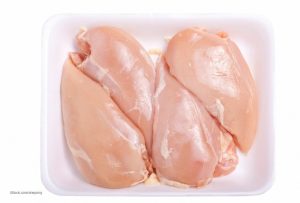A Salmonella illness has prompted a Foster Farms recall of boneless, skinless chicken breast produced in March. The limited recall, which now only applies to products consumers may have frozen, is the only recall the company has issued in the 10 months since it was first linked to a Salmonella outbreak that had sickened at least 574 people in 27 states by the end of May. It was issued at the request of the U.S. Department of Agriculture’s Food Safety and Inspection Service (USDA’s FSIS) “because this product is known to be associated with a specific illness,” according to the announcement.
 On the packaging of recalled products, the establishment number “P6137,” P6137A” or “P7632” appears inside the USDA mark of inspection. The recalled boneless, skinless chicken products, produced March 8, 10 and 11, were shipped to Costco, Foodmaxx, Kroger, Safeway and other retail stores and distribution centers in Arizona, California, Colorado, Idaho, Montana, New Mexico, Nevada and Utah. To see the full list of products click here.
On the packaging of recalled products, the establishment number “P6137,” P6137A” or “P7632” appears inside the USDA mark of inspection. The recalled boneless, skinless chicken products, produced March 8, 10 and 11, were shipped to Costco, Foodmaxx, Kroger, Safeway and other retail stores and distribution centers in Arizona, California, Colorado, Idaho, Montana, New Mexico, Nevada and Utah. To see the full list of products click here.
Salmonella poisoning causes diarrhea, abdominal cramps, and fever that usually develop within 12 to 72 hours after eating the contaminated product and last four to seven days. Children, seniors and pregnant women are most at risk.
On June 23, the Centers for Disease Control and Prevention (CDC), which has been tracking the outbreak, notified FSIS of one case of food poisoning from Salmonella Heidelberg that had been linked through epidemiological evidence to Foster Farms boneless skinless chicken breast product. The case patient, from California, first became ill on May 5, 2014.
“Until this point, there had been no direct evidence that linked the illnesses associated with this outbreak to a specific product or production lot,” FSIS said, prompting some to wonder why evidence was sufficient for the CDC to link the company to the outbreak but not for FSIS to ask for a recall. According to FSIS, “evidence that is required for a recall includes obtaining case-patient product that tests positive for the same particular strain of Salmonella that caused the illness, packaging on product that clearly links the product to a specific facility and a specific production date, and records documenting the shipment and distribution of the product from purchase point of the case-patient to the originating facility.”
What FSIS is describing is evidence from epidemiologic, laboratory, and traceback investigations. Every update the CDC has issued since the initial announcement in October has included the following statement: “epidemiologic, laboratory, and traceback investigations conducted by local, state, and federal officials indicate that consumption of Foster Farms brand chicken is the likely source of this outbreak of Salmonella Heidelberg infections.”
Foster Farms posted a statement on its website describing the recall and the $75 million investment it has made to reduce Salmonella levels since the outbreak was announced.
“In October 2013, the U.S. industry average for Salmonella in poultry parts was 25 percent. At that time, Foster Farms began implementing a multi-hurdle program, designed to reduce Salmonella at each stage of the production process – from ranches where the birds are raised, to the plants where they are processed. By March 2014, when these products were produced, Foster Farms Salmonella prevalence levels companywide were less than 10 percent. Additional improvements since March have reduced Salmonella levels to less than 5 percent.”
The company says it sharing its knowledge with other producers by leading a specialized U.S. poultry industry working group on Salmonella reduction. And that through “collaboration and data sharing with the USDA, the company is helping to set the new industry standard.”




